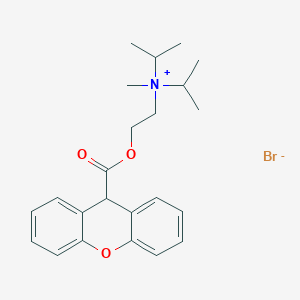Adjunct in peptic ulcer, Adult enuresis, Gastrointestinal tract spasm, Hyperhidrosis
Adult: Initially, 15 mg tid and 30 mg at bedtime, then adjust dose according to patient's clinical response and tolerance. Max: 120 mg daily.
|
Indications and Dosage
Oral
Adjunct in peptic ulcer, Adult enuresis, Gastrointestinal tract spasm, Hyperhidrosis Adult: Initially, 15 mg tid and 30 mg at bedtime, then adjust dose according to patient's clinical response and tolerance. Max: 120 mg daily.
|
|
Administration
Should be taken on an empty stomach. Take 30 min before meals and at bedtime.
|
|
Contraindications
Obstructive disease of the gastrointestinal tract (e.g. pyloroduodenal stenosis, paralytic ileus, achalasia); obstructive uropathy (e.g. bladder-neck obstruction due to prostatic hypertrophy), intestinal atony, severe ulcerative colitis, toxic megacolon, hiatal hernia associated with reflux oesophagitis, unstable CV adjustment in acute haemorrhage, myasthenia gravis, glaucoma; tachycardia secondary to cardiac insufficiency or thyrotoxicosis.
|
|
Special Precautions
Patient with ulcerative colitis, autonomic neuropathy, hyperthyroidism, CV disease (e.g. coronary artery disease, CHF, hypertension, acute MI) or severe heart disease, pyrexia, GERD, known or suspected gastrointestinal infections, chronic lung disease, Down's syndrome. Patient subjected to hot weather and/or exercise. Avoid use in patients with ileostomy or colostomy. Renal and hepatic impairment. Elderly. Pregnancy and lactation.
|
|
Adverse Reactions
Significant: Drowsiness, blurred vision, diarrhoea, heat prostration (in presence of high environmental temperature), reduced bronchial secretions.
Cardiac disorders: Bradycardia followed by tachycardia, palpitations, arrhythmias. Eye disorders: Dilatation of pupils with loss of accommodation and sensitivity to light, increased intraocular pressure. Gastrointestinal disorders: Dryness of the mouth, difficulty in swallowing, constipation, nausea, vomiting, ageusia. General disorders and administration site conditions: Thirst, weakness. Immune system disorders: Hypersensitivity reactions. Nervous system disorders: Dizziness, headache. Psychiatric disorders: Nervousness, insomnia, mental confusion. Renal and urinary disorders: Urinary hesitancy and retention. Reproductive system and breast disorders: Suppression of lactation, impotence. Skin and subcutaneous tissue disorders: Dryness of the skin, decreased sweating. Vascular disorders: Flushing. |
|
Patient Counseling Information
This drug may cause drowsiness or blurred vision, if affected, do not drive or operate machinery.
|
|
Overdosage
Symptoms: Intensification of usual adverse effects (e.g. nausea, vomiting); CNS disturbances (e.g. excitement, restlessness, delirium, hallucinations), hyperthermia, respiratory depression, circulatory changes (e.g. flushing, fall in blood pressure, circulatory failure), coma; curare-like action (e.g. neuromuscular blockade resulting in muscular weakness and possible paralysis). Management: Supportive and symptomatic treatment. Perform gastric lavage or induce emesis. Administer activated charcoal. May control excitement by administering thiopental Na 2% solution via slow IV or diazepam (5-10 mg via IV or 10 mg via IM). During progression of curare-like effect to respiratory muscle paralysis, institute mechanical respiration and maintain until the return of effective respiratory action. Adequate hydration may also be required. Monitor and manage vital signs as necessary. Fever may be treated with cooling blanket or alcohol sponging. For severe cases, may consider administration of 0.5-2 mg of IV physostigmine and may repeat if needed up to a total of 5 mg.
|
|
Drug Interactions
Delayed gastric emptying caused by propantheline may alter the absorption of other drugs. May increase the serum digoxin levels when used concurrently with slow-dissolving digoxin tab. Enhanced absorption of nitrofurantoin. May reduce and delay the absorption of paracetamol. May reduce the absorption of ketoconazole and levodopa. May result in excessive muscarinic blockade with synthetic and semi-synthetic antimuscarinic agents, belladonna alkaloids, narcotic analgesics (e.g. pethidine), class I antiarrhythmic drugs (e.g. procainamide, quinidine, disopyramide), TCAs, phenothiazines, antihistamines, or other drugs with antimuscarinic activity. May reduce effects of haloperidol and sublingual tab of nitrates. May antagonise the gastrointestinal activity of domperidone, cisapride, metoclopramide. May antagonise the effects of parasympathomimetics. May potentiate sedative effect of phenothiazines. May enhance the ulcerogenic effect of K chloride. May result in increased intraocular pressure with corticosteroids.
|
|
Food Interaction
Reduced bioavailability with food.
|
|
Action
Description:
Mechanism of Action: Propantheline bromide, a quaternary ammonium antimuscarinic agent, competitively blocks the action of acetylcholine at the postganglionic parasympathetic receptor sites leading to suppressed parasympathetic activity. This results in decreased gastric acid secretion and gastrointestinal motility. It also has spasmolytic properties. Onset: Antimuscarinic effect: Within 1 hour. Duration: Antimuscarinic effect: 6 hours. Pharmacokinetics: Absorption: Incompletely absorbed from the gastrointestinal tract. Reduced bioavailability with food. Time to peak plasma concentration: Approx 1 hour. Metabolism: Extensively metabolised in the liver via hydrolysis into inactive metabolites. Excretion: Via urine (3%; approx 70% as metabolites). Plasma elimination half-life: Approx 1.6 hours. |
|
Chemical Structure
 Source: National Center for Biotechnology Information. PubChem Compound Summary for CID 9279, Propantheline bromide. https://pubchem.ncbi.nlm.nih.gov/compound/Propantheline-bromide. Accessed July 28, 2021. |
|
Storage
Store between 20-25°C.
|
|
ATC Classification
A03AB05 - propantheline ; Belongs to the class of synthetic anticholinergics, quaternary ammonium compounds. Used in the treatment of functional bowel disorders.
|
|
References
Anon. Propantheline. Lexicomp Online. Hudson, Ohio. Wolters Kluwer Clinical Drug Information, Inc. https://online.lexi.com. Accessed 15/06/2021. Buckingham R (ed). Propantheline Bromide. Martindale: The Complete Drug Reference [online]. London. Pharmaceutical Press. https://www.medicinescomplete.com. Accessed 15/06/2021. Joint Formulary Committee. Propantheline Bromide. British National Formulary [online]. London. BMJ Group and Pharmaceutical Press. https://www.medicinescomplete.com. Accessed 15/06/2021. Pharmacy Retailing (NZ) Ltd Trading. Pro-Banthine Tablet 15 mg data sheet 13 May 2019. Medsafe. http://www.medsafe.govt.nz. Accessed 15/06/2021. Pro-Banthine Tablets 15 mg (Kyowa Kirin Limited). MHRA. https://products.mhra.gov.uk. Accessed 15/06/2021. Propantheline Bromide Tablet, Film Coated (West-Ward Pharmaceuticals Corp.). DailyMed. Source: U.S. National Library of Medicine. https://dailymed.nlm.nih.gov/dailymed. Accessed 15/06/2021.
|